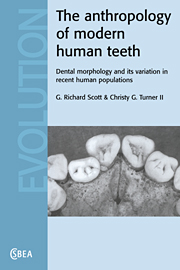 The Anthropology of Modern Human Teeth
The Anthropology of Modern Human Teeth Book contents
- Frontmatter
- Dedication
- Contents
- Acknowledgments
- Prologue
- 1 Dental anthropology and morphology
- 2 Description and classification of permanent crown and root traits
- 3 Biological considerations: ontogeny, asymmetry, sex dimorphism, and intertrait association
- 4 Genetics of morphological trait expression
- 5 Geographic variation in tooth crown and root morphology
- 6 Establishing method and theory for using tooth morphology in reconstructions of late Pleistocene and Holocene human population history
- 7 Tooth morphology and population history
- Epilogue
- Appendixes
- References
- Index
6 - Establishing method and theory for using tooth morphology in reconstructions of late Pleistocene and Holocene human population history
Published online by Cambridge University Press: 05 September 2015
- Frontmatter
- Dedication
- Contents
- Acknowledgments
- Prologue
- 1 Dental anthropology and morphology
- 2 Description and classification of permanent crown and root traits
- 3 Biological considerations: ontogeny, asymmetry, sex dimorphism, and intertrait association
- 4 Genetics of morphological trait expression
- 5 Geographic variation in tooth crown and root morphology
- 6 Establishing method and theory for using tooth morphology in reconstructions of late Pleistocene and Holocene human population history
- 7 Tooth morphology and population history
- Epilogue
- Appendixes
- References
- Index
Summary
Introduction
Today, biological anthropology encompasses subfields that focus on various aspects of primate and human variation, adaptability, and evolution. Even with numerous methodological and theoretical developments over the last 150 years, one of the major objectives of biological anthropology predates Charles Darwin, evolutionary theory, and the discovery and/or recognition of primate and hominid fossils. During the first half of the nineteenth century, the natural historians who laid the foundations for biological anthropology were concerned with human variation. Their avowed purpose was to systematize the ‘varieties of man’ (i.e., racial classifications) and provide insights into the course of human history. These early classifications were seldom free of assumptions about racial superiority, and most confused the causal relationships between, and independence of, biological, linguistic, and cultural variables. Despite the growth and diversity of modern biological anthropology, the field has not abandoned one of its initial goals-reconstructing human population history through the analysis of biological variation.
From the early 1800s to 1950, research in human variation dealt primarily with visible traits (e.g., skin color) and body dimensions (anthropometry for the living, osteometry for skeletons). Less emphasis was placed on other traits and systems such as dermatoglyphics, serology, and the dentition. In 1950, the immunologist W.C. Boyd opined that traditional studies of human variation emphasizing measurements and qualitative traits of unknown inheritance were passe. He advocated the use of serological characters (e.g., ABO, Rh, and MN blood group antigens) to resolve anthropological, historical, and evolutionary problems because they: (1) could be objectively observed with little or no inter observer error; (2) were not alterable by environmental factors during development; (3) had simple and known modes of inheritance; (4) were not subject to the action of natural selection (i.e., nonadaptive); and (5) did not mutate at a high rate.
Although Boyd explicitly discussed blood group genes in the context of human racial classifications, his primary interest was nonetheless in historical problems: ‘If the anthropologist is not content with the current popular classification of men into ‘races’ and nations, it is partly because he hopes to find something more fundamental, such as a classification which will tell him something of the history of the human race’ (Boyd, 1950:15), in other words, an evolutionary classification.
- Type
- Chapter
- Information
- The Anthropology of Modern Human TeethDental Morphology and its Variation in Recent Human Populations, pp. 243 - 268Publisher: Cambridge University PressPrint publication year: 1997


